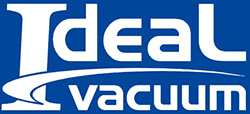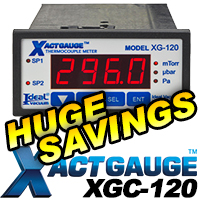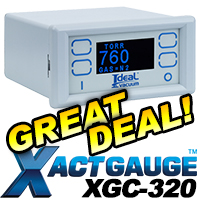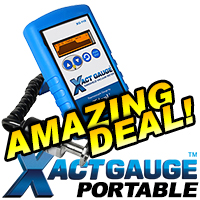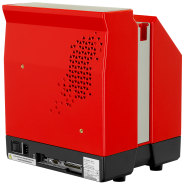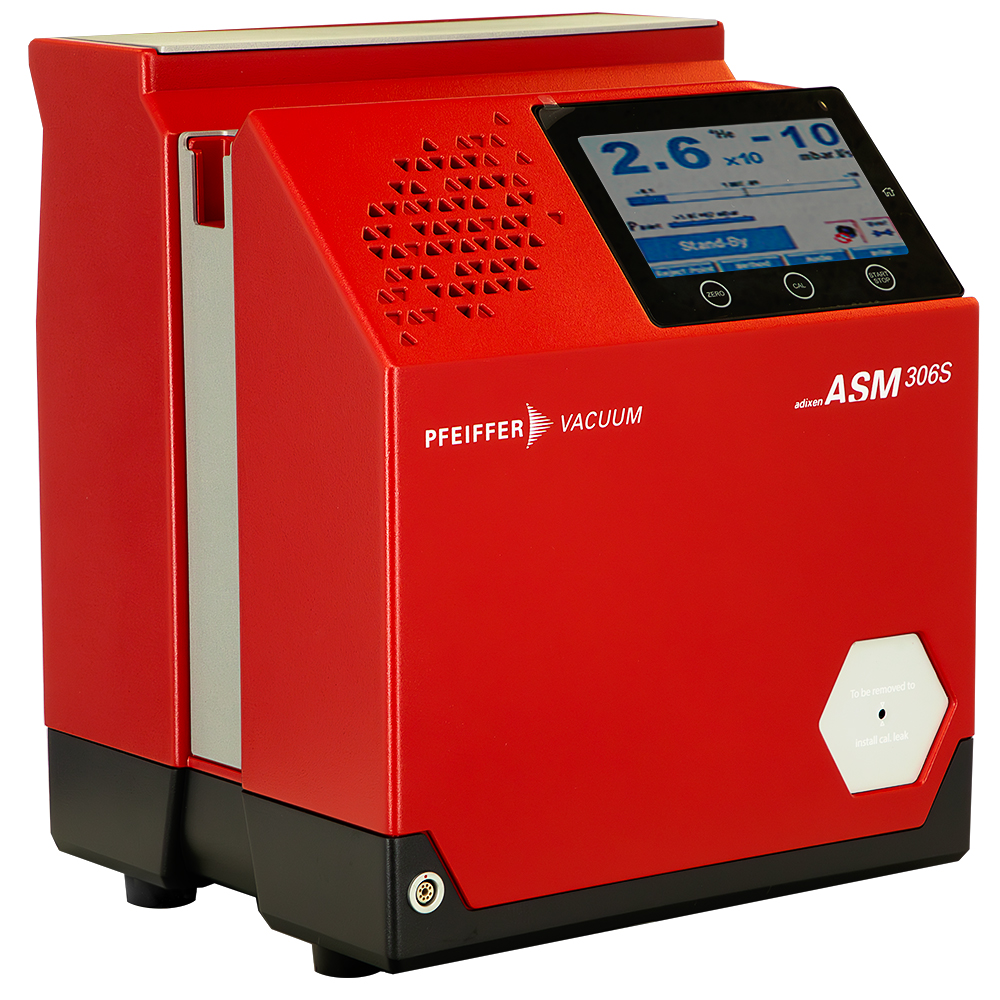Pfeiffer ASM 306 S Ultra Compact Helium Leak Detector with 37 Pin I/O Interface Board, USB and Ethernet.
Pfeiffer Part Number: RSAS00A4MM9A.
The Pfeiffer ASM 306 S is a helium (4He) and hydrogen (H2) sniffer leak detector perfect for leak localization on pressurized parts. The ASM 306S has a built-in internal dry diaphragm backing pump, is ultra-compact, lightweight, and small enough to place on a bench top. This sniffer leak detector features a large, easy-to-use high resolution graphic color touch screen with intuitive menu for easy operation. Its small size, rugged design, and universal input voltage enables the ASM 306S to be operated anywhere in the world. It is the perfect choice for integration into a production line, whether for manual or automated operation.
The ASM 306 S is characterized by its quick 2 minute start-up time, fast response time (<1 s), and short recovery time. It is well suited for maintenance applications as well as small production environments. The minimum detectable leak rate for this unit in vacuum mode is 1x10
-7 mbar l/s for 4He, and 5x10
-7 mbar l/s for H2. Sniffer probe flow is 300 sccm ± 10%.
This ASM306S leak detector includes the 37 pin communication I/O interface board with USB and Ethernet connections which allows the user to create an additional COM port to operate the leak detector through a computer. This ASM 306 S sniffer leak detector with 37 pin I/O interface board with USB and Ethernet is Pfeiffer part number RSAS00A4MM9A.
Hybrid sniffer probes and cables in lengths from 2 m to 10 m, and a two-wheel trolley for effortless portability are available separately as accessories. Please see the downloads for the operating instruction manual and brochure for the ASM 306 S sniffer leak detector and the manual for the 37 pin I/O interface card.
Pfeiffer ASM 306 S Features:
- Small footprint and compact size, only 14" x 12" x 17"
- Lightweight and portable, only 49 lbs (22 kg)
- Universal input voltage 100-240 VAC, max. 300VA
- Minimum detectable leak rate 1x10-7 mbar l/s for 4He
- Minimum detectable leak rate 5x10-7 mbar l/s for H2
- Large, easy-to-use high resolution graphic color touch screen
- Intuitive menu for easy operation
- 2 minute start-up time
- Fast response time (<1 s)
- Finds localized leaks on pressurized parts
- Highest reliability and accuracy for full-time testing operation
- Repeatable and high sensitivity measurements
- Fully configurable I/O interface (37 pins D-Sub) for control via PCs/PLCs Ethernet communication
- Probes and test leaks ordered separately
- Optional 2 wheel trolley for effortless portability
Pfeiffer ASM 306 S Optional Accessories:
- Hybrid sniffer probe, 2 m length, rigid nozzle, PN: PRB2H02HA
- Hybrid sniffer probe, 5 m length, rigid nozzle, PN: PRB2H05HA
- Hybrid sniffer probe, 2 m length, rigid nozzle, PN: PRB2H10HA
- Hybrid cable, 2 m length, PN: A604523
- Hybrid cable, 5 m length, PN: A602086
- Hybrid cable, 2 m length, PN: A602106
- Replacement tip filters for hybrid probes, PN: 127829S
- Replacement small particle filters for hybrid probes, PN: 128051
- Calibrated Leak, 100% Helium, value between 4-6x10 -5 mbar l/s, PN: 127388
- Calibrated Leak, 100% Hydrogen, value between 4-6x10 -5 mbar l/s, PN: 127387
- Trolley, PN: 114820
Helium Leak Testing Basics
Helium mass spectrometry, or helium leak testing, is a highly precise means of leak detection. This technology was first developed for the Manhattan Project during World War II to locate extremely small leaks in the gas diffusion process.
At the heart of helium leak testing is a complex piece of equipment called a helium mass spectrometer. Quite simply, this machine is used to analyze air samples (which are introduced into the machine via vacuum pumps) and provides a quantitative measurement of the amount of helium present in the sample. In practice, a "leak," is identified by a rise in the level of helium being analyzed by the machine.
Helium leak testing can identify extremely small leaks. For example, our equipment can detect a leak so small that it would emit just two cubic centimeters of helium (or the amount equal to two sugar cubes) in 320 years. While very few applications require this level of precision, this example serves to highlight the accuracy possible with this process.
While helium leak detection may appear to be a simple procedure, the process involves a combination of both art and science. The user must ensure the equipment is functioning properly and the process is highly dependant upon the user’s experience. Consider this analogy: while anyone with enough money can buy an airplane, learning how to fly one takes a lot of practice. The same is true with helium leak detection-make sure your "pilot" knows how to fly.
Why Is Helium Superior?
While many gases are used in leak detection, helium’s qualities provide for superior testing. Having an AMU (Atomic Mass Unit) of only 4, helium is the lightest inert gas. Only hydrogen, with an AMU of 2, is lighter than helium. However, due the hydrogen’s explosive potential it is rarely used.
Additional reasons why helium is a superior tracer gas:
- Only modestly present in the atmosphere (roughly 5 parts per million)
- Flows through cracks 2.7x faster than air
- Nontoxic
- Nondestructive
- Nonexplosive
- Inexpensive
- User Friendly
Due to these attributes, and its high sensitivity, helium leak testing has gained broad acceptance in a wide range of leak testing applications. Helium Leak Testing’s two primary testing modes while there are a variety of testing procedures, in general there are:
Two primary methods of helium leak testing:
- Spray Probe
- Sniffer Probe
The choice between these two modes is based on both the size of the system being tested, as well as, the level of sensitivity required.
Spray Probe: Provides Maximum Sensitivity
For this technique, the leak detector is hooked directly to the system under test and the inside of the system is evacuated. Once an acceptable vacuum is achieved, helium is sprayed discreetly on the outside of the system, with particular attention being paid to any suspect locations. Any leaks in the system, including defective welds (caused by cracks, pin holes, incomplete welds, porosity, etc.), flawed or missing gaskets, leaks due to loose clamps, or any other defect will allow helium to pass and be readily detected by the machine. The source of any leaks can then be accurately pinpointed and repaired.
The spray probe process is used to achieve the highest level of sensitivity. The equipment being used dictates the maximum sensitivity achievable; in Jurva Leak Testing’s case it is 2x10-10 std cc/sec. This technique does require that the system being tested is relatively leak tight prior to testing, as an ample vacuum is required for testing. However, by using special throttling devices a gross test can typically be performed. The gross test should eliminate any major leaks, permitting the use of increased sensitivity.
The following are examples of systems that we test using the spray probe technique:
- A-bar furnaces
- E-beam systems
- Laser systems
- Metal deposition equipment
- Distillation systems
- Vacuum systems
Sniffer Probe
For this technique, helium is purged throughout the inside of system being tested. Due to the innate properties of helium it readily migrates throughout the system and in its attempt to escape penetrates any imperfections, including: defective welds (caused by cracks, pin holes, incomplete welds, porosity, etc.), flawed or missing gaskets, leaks due to loose clamps, or any other defect. The system’s exterior is then scanned by using a probe attached to the leak tester. Any leaks will result in an increased level of helium nearest the source and be readily detected. Leak sources can then be pinpointed, providing the opportunity for immediate repair and retest.
Unlike the spray probe technique, this process is very flexible and can be adapted to meet the needs of any virtually any system in which helium can be injected. There is no practical size limitation. The sniffer probe technique is not as sensitive as the spray probe process, however, due to the amount of helium present in the air (approximately 5 ppm). The maximum sensitivity achievable under this procedure is approximately 1x10-6 std cc/sec. Nevertheless, this process is vastly superior to other traditional leak testing methods, such as: bubble testing, acoustic emission, liquid penetrant or vacuum box testing.
The following list is an example of systems that Jurva Leak Testing has tested using the sniffer probe process:
- Storage tanks (both above ground and below)
- Floating roofs
- Underground pipelines
- Underground cables
- Aseptic systems (flash coolers, heat exchangers, fillers, etc.)
- Any vessel/line or system that can be pressurized
